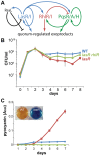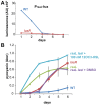Stationary phase-specific virulence factor overproduction by a lasR mutant of Pseudomonas aeruginosa
- PMID: 24533146
- PMCID: PMC3923063
- DOI: 10.1371/journal.pone.0088743
Stationary phase-specific virulence factor overproduction by a lasR mutant of Pseudomonas aeruginosa
Abstract
Secreted virulence factors of the human pathogen Pseudomonas aeruginosa are often under quorum sensing control. Cells lacking the quorum-sensing regulator LasR show reduced virulence factor production under typical laboratory conditions and are hypo-virulent in short-term animal infection models, yet lasR mutants are frequently associated with long-term infection in cystic fibrosis patients. Here, I show that in stationary-phase or slow-growth conditions, lasR cells continuously and strongly produce the important virulence factor pyocyanin while wild-type cells do not. Pyocyanin overproduction by lasR cells is permitted by loss of repression by RsaL, a LasR-dependent negative regulator. lasR cells also contribute pyocyanin in mixed cultures, even under "cheating" conditions where they depend on their wild-type neighbors for nutrients. Finally, some clinical P. aeruginosa isolates with lasR mutations can overproduce pyocyanin in the laboratory. These results imply that slow-growing clinical populations of lasR cells in chronic infections may contribute to virulence by producing pyocyanin under conditions where lasR⁺ cells do not.
Conflict of interest statement
Figures






References
-
- Driscoll JA, Brody SL, Kollef MH (2007) The epidemiology, pathogenesis and treatment of Pseudomonas aeruginosa infections. Drugs 67: 351–368. - PubMed
-
- Dietrich LE, Price-Whelan A, Petersen A, Whiteley M, Newman DK (2006) The phenazine pyocyanin is a terminal signalling factor in the quorum sensing network of Pseudomonas aeruginosa . Mol Microbiol 61: 1308–1321. - PubMed
Publication types
MeSH terms
Substances
Grants and funding
LinkOut - more resources
Full Text Sources
Other Literature Sources

